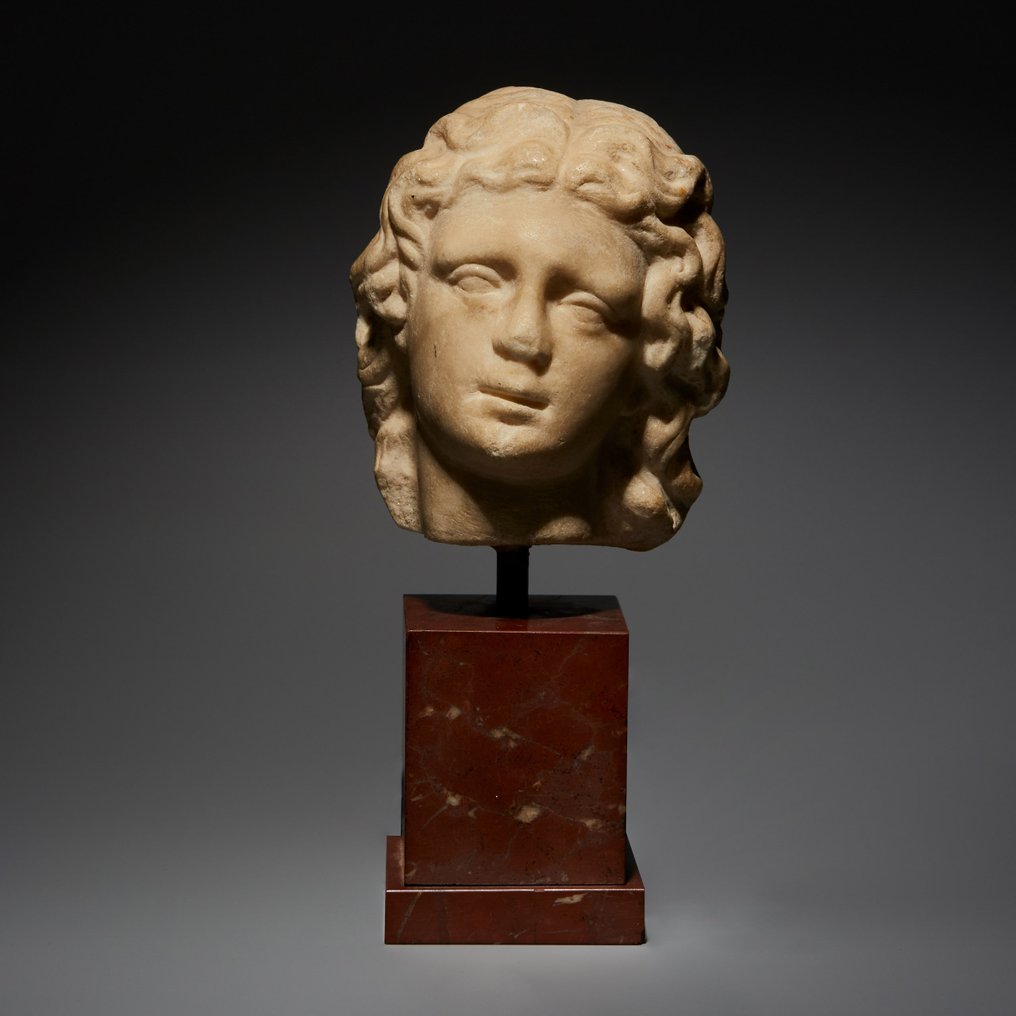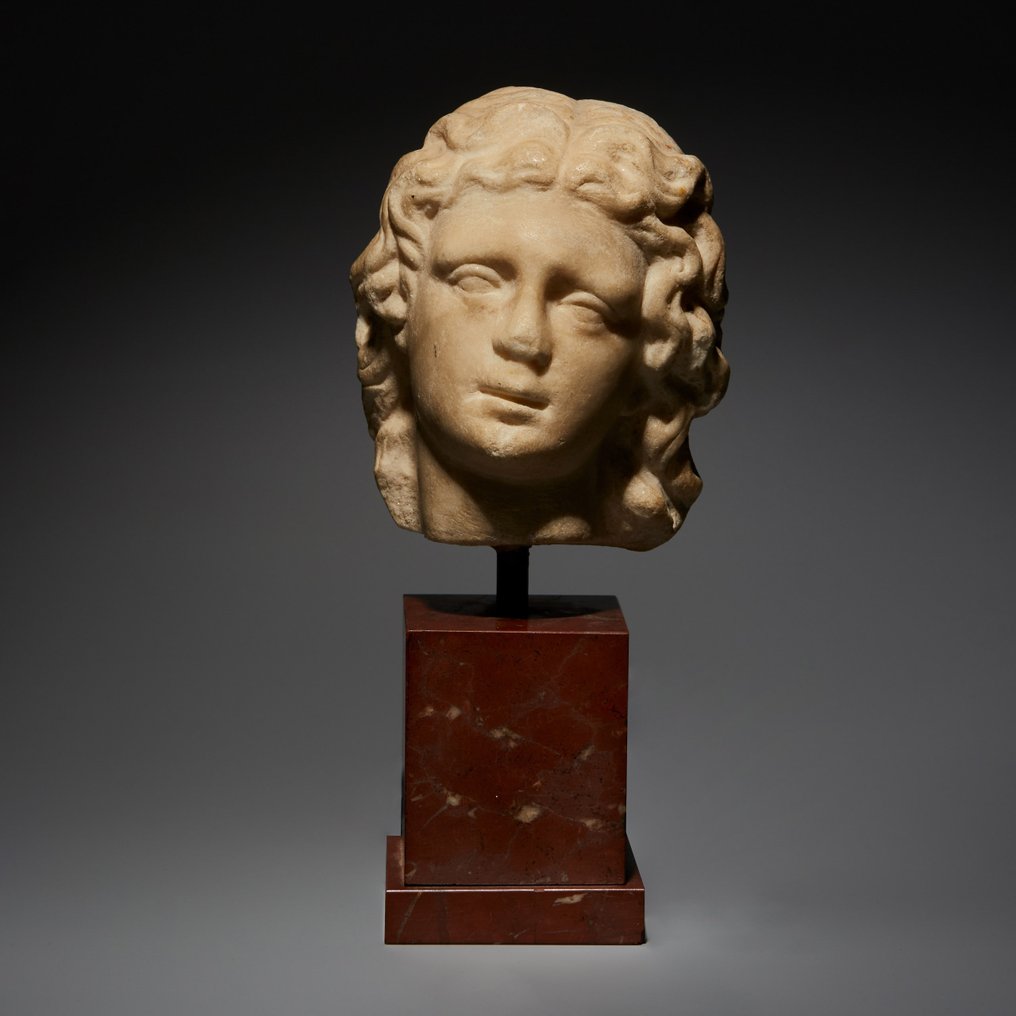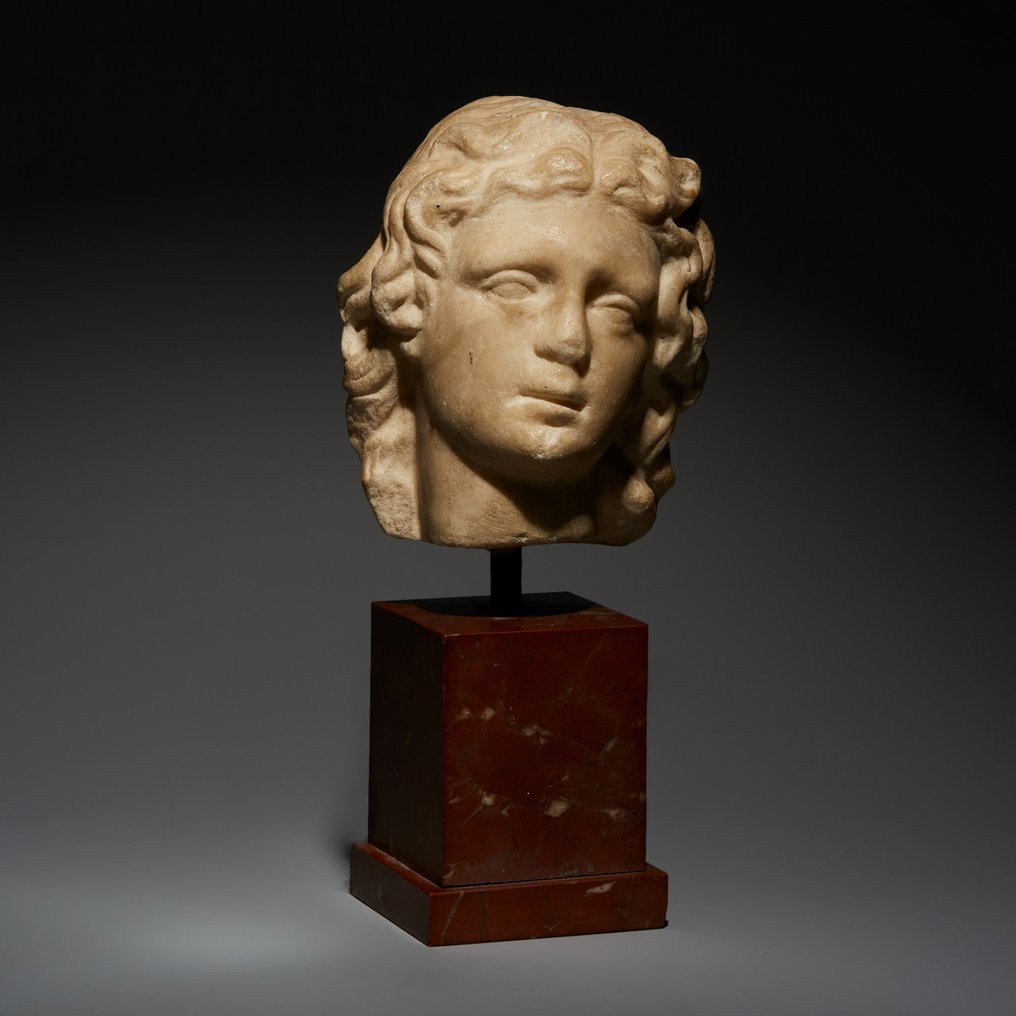Very nice oil lamp in good condition corresponding to the pictures.
Se oversættelseRomersk antik Marmor Amazon hoved. 1. - 2. århundrede e.Kr. 11,5 cm højde.
Nr. 92520029



Amazon Head
Ancient Roman, 1st - 2nd century AD.
Marble.
11.5 cm height.
Condition: Good state of conservation, without restorations. There is a scratch on the chin and a slight missing piece of hair on the back right.
Provenance: Private collection, Doullens, France, 1970 – 1908.
Description:
Head carved in marble in a round shape belonging to a sculpture of less than life size, about 90 cm in total height. It represents a youthful female face that follows the iconography of the wounded Amazon, developed from the models that Polycletus, Phidias, Cresilas and two other unknown sculptors, Cydon and Phradmon, created for the temple of Artemis in Ephesus around 440 BC. (fig. 1). Having lost strength, the head tilts to the left, the thick-lidded eyes narrow and the mouth relaxes and opens slightly, evoking a panting breath. The elegant languor of the figure, its expressive restraint and the grace of gesture and movement reveal the influence of classical Greek models, especially current in Roman art of the 1st and 2nd centuries AD. In Naples, an Amazon head very similar in expression is preserved, derived directly from Greek models from the 5th century BC. (fig. 2).
The carving is delicate and precise, with a facial modeling that balances idealization and naturalism in its combination of fluid lines, delicately curved on the cheeks, jaw, chin and neck, and a gently frowning brow that provides a content but expressive drama to the representation, characteristic of the Greek models of the second half of the 5th century BC. The loose and wavy hair frames the face, providing a dynamic play of contrast of light and shadow, and is worked with thick independent strands, moved and volumetric around the face and flatter, although equally individualized, on the back of the head. head.
In Greek mythology, the Amazons were a race of warriors and hunters, daughters of Ares and worshipers of Artemis. They lived, literally and symbolically, on the margins of the human world. Located by ancient Greek legends in Asia Minor, the steppes around the Black Sea or even Libya, were conceived as the embodiment of the wild, the opposite of civilization. That is why they generally appear in mythical narratives as opponents of the Greeks: the Amazon queen Penthesilea faced Achilles in a duel during the Trojan War, and her sister, Hippolyta, fought against Hercules in one of his twelve labors. . The theme of the Amazonomachy, the battle between men and Amazons as a symbolic confrontation between civilization and barbarism, was a frequent iconographic theme in Greece and also in Rome; It appears in the Treasury of the Athenians at Delphi and on the altar of Zeus in Pergamon, although perhaps the most important example is the series of metopes that Phidias made for the Parthenon in Athens.
Brave, brave and fearsome, the Amazons carried out military expeditions to the most distant corners of the world, from Scythia to Egypt, and were also considered founders of temples and ancient cities such as Ephesus or Smyrna. They had no relationship with men other than what was strictly necessary to reproduce, and they raised only the girls, returning the boys to their fathers. The discovery of tombs of warrior women in the Eurasian steppe suggests that the myth of the Amazons could be based on the encounters of the Greeks with queens and warriors of the nomadic horsemen people of the area - Scythians, Sarmatians and Hittites.
Bibliography:
- BOTHMER, D. von. Amazons in Greek Art. Oxford University Press. 1957.
- GRIMAL, P. The Dictionary of Classical Mythology. Wiley-Blackwell. nineteen ninety six.
- KLEINER, D.E. Roman Sculpture. Yale University Press. 1992.
Parallels:
Fig. 1 Wounded Amazon. Roman copy of the s. I AD from a Greek original from the 19th century. V BC Marble, 195 cm high. Ny Carlsberg Glyptotek, Copenhagen, inv. 1658.
Fig. 2 Wounded Amazon head. Roman copy of the s. I AD from a Greek original from the 19th century. V BC Marble, 31 cm high. Museo Archeologico Nazionale di Napoli (Italy), inv. 15041.
Notes:
The piece includes authenticity certificate.
The piece includes Spanish Export License.
Sælger's Historie
Amazon Head
Ancient Roman, 1st - 2nd century AD.
Marble.
11.5 cm height.
Condition: Good state of conservation, without restorations. There is a scratch on the chin and a slight missing piece of hair on the back right.
Provenance: Private collection, Doullens, France, 1970 – 1908.
Description:
Head carved in marble in a round shape belonging to a sculpture of less than life size, about 90 cm in total height. It represents a youthful female face that follows the iconography of the wounded Amazon, developed from the models that Polycletus, Phidias, Cresilas and two other unknown sculptors, Cydon and Phradmon, created for the temple of Artemis in Ephesus around 440 BC. (fig. 1). Having lost strength, the head tilts to the left, the thick-lidded eyes narrow and the mouth relaxes and opens slightly, evoking a panting breath. The elegant languor of the figure, its expressive restraint and the grace of gesture and movement reveal the influence of classical Greek models, especially current in Roman art of the 1st and 2nd centuries AD. In Naples, an Amazon head very similar in expression is preserved, derived directly from Greek models from the 5th century BC. (fig. 2).
The carving is delicate and precise, with a facial modeling that balances idealization and naturalism in its combination of fluid lines, delicately curved on the cheeks, jaw, chin and neck, and a gently frowning brow that provides a content but expressive drama to the representation, characteristic of the Greek models of the second half of the 5th century BC. The loose and wavy hair frames the face, providing a dynamic play of contrast of light and shadow, and is worked with thick independent strands, moved and volumetric around the face and flatter, although equally individualized, on the back of the head. head.
In Greek mythology, the Amazons were a race of warriors and hunters, daughters of Ares and worshipers of Artemis. They lived, literally and symbolically, on the margins of the human world. Located by ancient Greek legends in Asia Minor, the steppes around the Black Sea or even Libya, were conceived as the embodiment of the wild, the opposite of civilization. That is why they generally appear in mythical narratives as opponents of the Greeks: the Amazon queen Penthesilea faced Achilles in a duel during the Trojan War, and her sister, Hippolyta, fought against Hercules in one of his twelve labors. . The theme of the Amazonomachy, the battle between men and Amazons as a symbolic confrontation between civilization and barbarism, was a frequent iconographic theme in Greece and also in Rome; It appears in the Treasury of the Athenians at Delphi and on the altar of Zeus in Pergamon, although perhaps the most important example is the series of metopes that Phidias made for the Parthenon in Athens.
Brave, brave and fearsome, the Amazons carried out military expeditions to the most distant corners of the world, from Scythia to Egypt, and were also considered founders of temples and ancient cities such as Ephesus or Smyrna. They had no relationship with men other than what was strictly necessary to reproduce, and they raised only the girls, returning the boys to their fathers. The discovery of tombs of warrior women in the Eurasian steppe suggests that the myth of the Amazons could be based on the encounters of the Greeks with queens and warriors of the nomadic horsemen people of the area - Scythians, Sarmatians and Hittites.
Bibliography:
- BOTHMER, D. von. Amazons in Greek Art. Oxford University Press. 1957.
- GRIMAL, P. The Dictionary of Classical Mythology. Wiley-Blackwell. nineteen ninety six.
- KLEINER, D.E. Roman Sculpture. Yale University Press. 1992.
Parallels:
Fig. 1 Wounded Amazon. Roman copy of the s. I AD from a Greek original from the 19th century. V BC Marble, 195 cm high. Ny Carlsberg Glyptotek, Copenhagen, inv. 1658.
Fig. 2 Wounded Amazon head. Roman copy of the s. I AD from a Greek original from the 19th century. V BC Marble, 31 cm high. Museo Archeologico Nazionale di Napoli (Italy), inv. 15041.
Notes:
The piece includes authenticity certificate.
The piece includes Spanish Export License.
Sælger's Historie
- 785
- 8
- 3
Intaglio wie beschrieben und mit guter Dokumentation: Echtheitszertifikat und spanische Ausfuhrgenehmigung liegen dabei. Sehr seriös. Gerne wieder.
Se oversættelseGreat packing, good description, very happy
Se oversættelseSehr schön und wie beschrieben. Immer wieder gerne.
Se oversættelseBeautiful item Fast and safe shipping Recommended seller
Se oversættelseGreat as always. Thank you.
Se oversættelsetop 💯💯💯💯💯 come sempre :-)
Se oversættelseTrès bel objet, envoi rapide et soigné, vendeur recommandé
Se oversættelseExcelente como siempre, garantía total y rapidez en el envio. Gracias.
Se oversættelseExcellent service and beautiful piece, thank you very much.
Se oversættelsetrès belle piece merci
Se oversættelsebien arrivé, bien emballé, correspond à l'image. vendeur pro
Se oversættelseMerci! beaucoup de plaisir à la decouverte du pendentif ! Envoi rapide et emballage soigné
Se oversættelsePreciosa terracota y un molde de ojo udjat de una conocida colección. Como siempre mucha profesionalidad y garantía en el vendedor.
Se oversættelseAlles bestens , vielen Dank !! Gracias por la transacción sin problemas.
Se oversættelseTop vendeur professionnel 👍
Se oversættelseTodo perfecto 👌 gracias al equipo de Bagot.
Se oversættelseTot correcte+++ Moltes gràcies!!
Se oversættelseGreat
Se oversættelseSo beautiful!thank you very much!perfect!
Se oversættelseGreat
Se oversættelseGreat!!
Se oversættelseTutto bene PERFETTO ++++++
Se oversættelseOggetto delizioso
Se oversættelseMolto veloce 👍 tutto ok grazie ☺️
Se oversættelse- 785
- 8
- 3
Very nice oil lamp in good condition corresponding to the pictures.
Se oversættelseDisclaimer
Sælger garanterer og kan bevise, at genstanden er erhvervet på lovlig vis. Sælger er blevet informeret af Catawiki om, at skulle fremskaffe den dokumentation, der kræves af love og regler i dennes bopælsland. Sælger garanterer at være berettiget til, at måtte sælge/eksportere denne genstand. Sælger sørger for, at al information vedrørende proveniensen af en genstand vil blive videregivet til køber. Sælger sørger for, at eventuelle nødvendige tilladelser er blevet eller vil blive indhentet. Sælger vil omgående informere køber om eventuelle forsinkelser i forbindelse med indhentelse af sådanne tilladelser.
Sælger garanterer og kan bevise, at genstanden er erhvervet på lovlig vis. Sælger er blevet informeret af Catawiki om, at skulle fremskaffe den dokumentation, der kræves af love og regler i dennes bopælsland. Sælger garanterer at være berettiget til, at måtte sælge/eksportere denne genstand. Sælger sørger for, at al information vedrørende proveniensen af en genstand vil blive videregivet til køber. Sælger sørger for, at eventuelle nødvendige tilladelser er blevet eller vil blive indhentet. Sælger vil omgående informere køber om eventuelle forsinkelser i forbindelse med indhentelse af sådanne tilladelser.